Sustainability Activities (ESG)
Preserving Biodiversity
Policy on Biodiversity
Preserving Biodiversity
Policy on Biodiversity
The Mitsubishi Estate Group has implemented a policy of reducing and avoiding the impact and fostering harmony between nature and human society as part of the Mitsubishi Estate Group Basic Environmental Policy. Through its business activities, the Group considers biodiversity and promotes the creation of an attractive society in harmony with nature.
In addition, the Group does not engage in development in areas designated as World Heritage Sites or in areas designated as I through IV under the International Union for Conservation of Nature (IUCN). When the Group engages in development of land likely to have an impact on biodiversity, it consults with governments, NGOs, and other external partners to take appropriate mitigation measures and remedial action.
In accordance with these policies, all Group companies consider biodiversity in the course of their business activities and develop biodiversity-friendly initiatives cooperating with NPOs and other external partners. The Group also promotes obtaining the Association for Business Innovation in harmony with Nature and Community's ABINC certification at properties with a certain amount of green space.
Through such initiatives, the Group strives to achieve a net positive impact. The Group also asks tier 1 suppliers as well as non-tier 1 suppliers to take similar initiatives aimed at a net positive impact as it works to achieve its goals throughout the value chain.
Goals and Achievement Status
Goals and Achievement Status
As part of its efforts to ensure development in tandem with consideration for biodiversity, the Group promotes projects while holding hearings with governments and other external stakeholders starting from the project concept stage in order to comply appropriately with various environment-related laws and regulations (Forest Act, Urban Park Act and Natural Parks Acts, and Nature Conservation Act, etc.)
For example, before development, the Group works with governments to survey and provide specific protection for rare species, relocating them if necessary and periodically monitoring and reporting on them after relocation. For large-scale developments, the Group conducts an evaluation of the impact on the surrounding environment (an environmental assessment) in accordance with the Environmental Impact Assessment Act.
Moreover, Mitsubishi Estate Residence, which works on housing projects, has implemented the BIO NET INITIATIVE* as a program to plant trees and plants in a manner that will consider preserving biodiversity for all of its condominiums to be developed under The Parkhouse, the mainstream brand for the company's built-for-sale condominiums, regardless of the project size and land area. In implementing the initiative, the company has prepared biodiversity preservation guidelines composed of five main actions.
The guidelines incorporate actions such as not using invasive plants including specified foreign organisms and invasive alien species defined by the government, confirming the local plants around the project site and nurturing vegetation that is suitable for the area, and reducing chemical spaying as much as possible to lessen impact on earthworms and mole crickets, in addition to promoting the growth of plants utilizing the vital energy of the soil. The plan is to reduce the impact on the habitat of plants and animals in the area around the development and provide stopovers for diverse organisms through planting and maintenance.
In this way, the program provides an environmentally-friendly habitat for these diverse organisms while reducing the impact on biodiversity, and thereby strives to achieve a net positive impact, including the creation of habitat for plants and animals in the surrounding area.
Five Actions and Specific Examples
Five Actions and Specific Examples
| Actions | Specific examples |
|---|---|
| (1) Protect | - Do not use invasive plants such as specified foreign organisms and invasive alien species defined by the government. |
| (2) Nurture | - Confirm the local plants around the project site and nurture vegetation that is suitable for the area. - Use Japanese native species for at least 50% of plantings. |
| (3) Connect | - Help to secure stopovers for birds and butterflies flying in the area by creating an affinity with street greenery in the neighborhood and incorporating local native species. |
| (4) Utilize | - Reduce heavy pruning as much as possible and utilize the natural shapes of the trees. - Reduce chemical spraying as much as possible to lessen impact on earthworms and mole crickets, in addition to promoting the growth of plants utilizing the vital energy of the soil. |
| (5) Reduce | - Control the incidence of weeds and reduce weed control costs through dense plantings of low shrubs and ground cover and the spreading wood chips, etc. on the surface to reduce exposure of the soil. |
Scroll horizontally
- The initiative commenced in February 2015.
See the following for more information on efforts related to the BIO NET INITIATIVE.
Initiatives in the Marunouchi Area>Working to Improve the Waterfront Environment and Preserve the Ecosystem of the Imperial Palace Moat
Initiatives in the Marunouchi Area
Working to Improve the Waterfront Environment and Preserve the Ecosystem of the Imperial Palace Moat


The biota of the Imperial Palace moat had become degraded, hindering the natural generation of its native water plants. In October 2017, Mitsubishi Estate signed an agreement with the Ministry of the Environment to promote use of natural resources of the Imperial Palace Outer Garden, and launched the Moat Project in May 2018. The project aims to improve the waterfront environment of the Imperial Palace moat and conserve the endangered rare water plant species. This is the first such project for a private company, implemented through a collaboration with NGOs and other institutions, including the Ministry of the Environment, the Nature Conservation Society of Japan, the National Institute for Environmental Studies (NIES) Center for Climate Change Adaptation (CCCA), and the Natural History Museum and Institute, Chiba.
Flora and fauna taken from the moat are transferred to an aquarium on display at 3 × 3 Lab Future, a container biotope atop a building owned by Mitsubishi Estate or Hotoria Square,* thereby preserving it outside the area as alternatives to the Imperial Palace water environment.
Rare dragonflies such as the red damselfly are congregating in ponds where the water plants have been transplanted, and 11 species of water plants have been successfully restored since the project began, including the Mizohakobe (waterwort) (Elatine triandra var. pedicellata), previously regarded as extinct in the 23 wards of Tokyo on the Tokyo Red List 2010, which was successfully reintroduced in fiscal 2019. Six of the 11 species are not confirmed to be living in the Imperial Palace moat currently, with many of them on the Ministry of the Environment Red List or the Tokyo Red List and considered to be at risk of extinction.
Moreover, since 2019, water chestnuts cleared from the Imperial Palace moat in the project have been composted. The vegetables grown with the compost in Yatsugatake are used by the Mitsubishi Estate Group, creating a new resource cycle.
In addition to restoring and preserving the water environment, including the rare flora and fauna, the project aims to build a biodiversity network in the neighborhood around the moat, thereby revitalizing the ecosystem that was once widespread in the area, as well as utilizing these activities to create a more attractive city.
- Hotoria Square is an eco-friendly green space of approximately 3,000 square meters located on the west side of the Hotoria block, which consists of the Otemachi Park Building, where Mitsubishi Estate’s head office is located, and the adjacent Otemachi Tower-ENEOS Building in front of the Imperial Palace Outer Garden. It has obtained the ABINC certification (urban development and shopping center category) from the Association for Business Innovation in harmony with Nature and Community. Plantings mainly consist of native and local species that are found in the grove of the Imperial Palace. Also found in the square are a gently sloping body of water, stone walls, and nesting boxes for birds. Through these initiatives, Mitsubishi Estate is promoting environmental improvement and ecosystem preservation in the Marunouchi area of Tokyo.
Three Moat Project activity sites and their functions
(1) 3 × 3 Future Lab (Exhibition):
An aquarium that simulates the high-water quality environment of the moat to cultivate successfully regenerated water plants.

(2) Otemachi Building rooftop (Germination experiments):
Several large-capacity aquariums have been installed for conducting germination experiments with seeds of water plants lying dormant in mud taken from the moat and other water plant conservation activities.

(3) Hotoria Square (Restoration of ecosystem):
In addition to germination experiments with water plants, water plants have actually been introduced into the pond in the square. The introduced water plants have become established and are contributing to the restoration of the local ecosystem.

OMY Area Green Space Maintenance and Management Plan Obtains TSUNAG Certification, the First in Its Class
On March 18, 2025, Mitsubishi Estate together with the Association for Creating Sustainability in Urban Development of the Otemachi, Marunouchi, and Yurakucho Districts (Ecozzeria Association) received certification under the Certification System for Securing Quantity and Quality Urban Green Space (TSUNAG) for the maintenance and management plan for green spaces (Hotaria Square,*1 Ichigokan Plaza,*2 and Marunouchi Building exterior) in the Otemachi-Marunouchi-Yurakucho (OMY) area. This is the first certification (Double Star rating*3) for multiple green spaces in collaboration with an area management organization.
TSUNAG is a system for evaluating and certifying the efforts of private companies to secure quality urban green spaces established by the Ministry of Land, Infrastructure, Transport and Tourism in 2024. Although the green space in the OMY area consists of individual green spaces located a certain distance apart, the continuity of green space has been preserved through appropriate plantings based on the urban development policy and green space development plan for the area as a whole. In addition, the area has established a plan for maintaining and managing the green space with an emphasis on preserving biodiversity and coexisting with nature. It was also recognized for promoting efforts with the participation of diverse stakeholders, including companies, employees, and visitors in the area, as well as government.
Going forward, Mitsubishi Estate and the Ecozzeria Association will work with experts to promote maintenance and management of green space that preserves biodiversity, responds to climate change, and improves human well-being based on the established maintenance and management plan with the aim of realizing a nature-positive society in harmony with nature.
Further, the green space development and management plan for Grand Green Osaka (Umekita Phase 2), a development project led by Mitsubishi Estate, has also received Triple Star certification, the highest TSUANG rating.
- Selected as one of the first Natural Symbiosis Sites by the Ministry of the Environment in October 2023
- An inner courtyard enclosed by the Marunouchi Park Building and Mitsubishi Ichogokan
- Projects that are eligible for certification are ranked in three levels based on the quantity and quality of green space after fulfilling the conditions for certification. (In descending order: Triple Star, Double Star, Single Star)
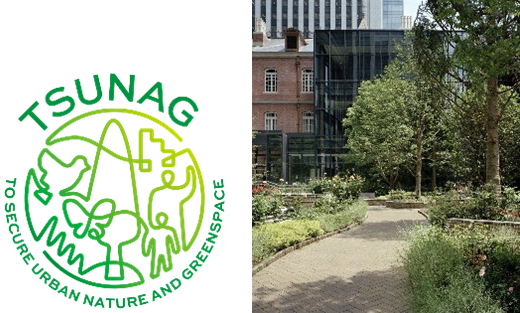
Ichigokan Plaza
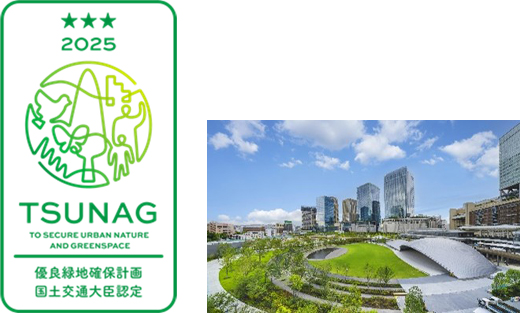
Umekita Park and the Grand Green Osaka North Wing as viewed from the South Wing
Obtained First Natural Symbiosis Site Certification for Hotoria Square
In October 2023, Hotoria Square, an environmentally-friendly green space located on the west side of the Hotoria block composed of the Otemachi Park Building where Mitsubishi Estate’s head office is housed and the adjacent Otemachi Tower-ENEOS Building, was selected as one of the first natural symbiosis sites by the Ministry of the Environment.
“Natural symbiosis sites” are areas certified by the national government where biodiversity is conserved through efforts by the private sector, and certified areas will be registered as “other effective area-based conservation measures” (OECMs) in an international database.
Japan puts particular importance on 30by30 (a target for at least 30% of land and marine areas to be protected by 2030 to realize a nature positive world by halting and reversing biodiversity loss to put nature on a recovery track), a target which is included in the global targets for 2030 under the Kunming-Montreal Global Biodiversity Framework adopted in December 2022. The natural symbiosis sites initiative is part of the nation’s efforts aimed at achieving the 30by30 target.
Hotoria Square is managed with consideration given to biodiversity and creates harmony with the rich natural and historical landscape of the adjacent Imperial Palace moat. Mitsubishi Estate will work with the Association for Creating Sustainability in Urban Development of the Otemachi, Marunouchi, and Yurakucho Districts (commonly known as the Ecozzeria Association) and environmental experts to continue efforts to conserve, restore, and utilize biodiversity, aiming to realize a nature-positive world through the Moat Project, biological surveys, environmental education, and regular nature programs.
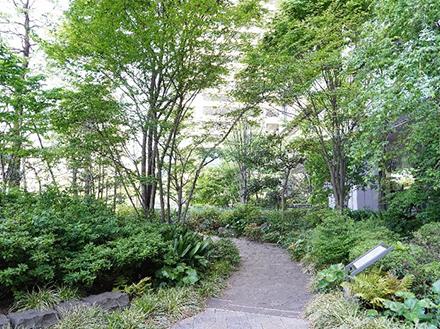
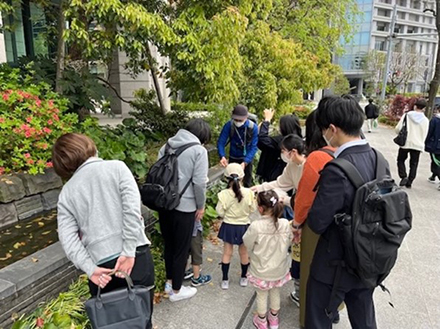
Biomonitoring in the Marunouchi District
Biomonitoring in the Marunouchi District

The Marunouchi District is bordered by the Imperial Palace and moat, Hibiya Park, and other green spaces that conserve the precious natural ecosystem in this urban neighborhood, making it a good place to observe varied animal and plant life throughout the year. Mitsubishi Estate has been running a biomonitoring survey in the Marunouchi district since 2009, in collaboration with the NPO Center for Ecological Education. It compiled the results of the survey and published the Marunouchi Living Things Handbook in June 2013. The Handbook provides information about the abundance of nature in the district and also suggests ways in which individuals can help protect biodiversity in their own areas. By doing so, the Handbook aims to function as a PDCA tool for ecosystem management in the district.
This initiative received positive feedback and won the Japan Committee for UNDB Award in the Tokyo Region Biodiversity Contest, held at the GTF Green Challenge Awards 2013 organized by the GTF Greater Tokyo Festival Executive Committee. The company will press on with its efforts to preserve biodiversity in the future.
Initiatives in The Edible Park Otemachi by Grow, the Otemachi Building’s Rooftop Vegetable Garden

In May 2022, Mitsubishi Estate completed a major renovation of the Otemachi Building, originally constructed in 1958, and opened the Otemachi Building Sky Lab, a rooftop area of approximately 4,000m2, creating a new space for human interaction.
The Otemachi Building Sky Lab features The Edible Park Otemachi by Grow (658m2, management: PLANTIO, Inc.), Tokyo’s biggest rooftop vegetable garden, in addition to a lush green workspace and other areas that, prior to its renewal, had been a typically utilitarian commercial building rooftop.
About 40 kinds of vegetables will be grown based on user participation starting from the stage of soil preparation, with the focus being on heirloom vegetable species considered native to Tokyo. The “grow GO” vegetable growing app allows users to monitor the growth of vegetables and take part in harvesting upon maturation. The aim is for the vegetable garden to become a hub for sustainable interaction with workers in the building, visitors, and food handlers through agriculture and food.
Initiatives in Other Areas>Taking on Nature-Positive Activities in Minakami, Gunma Prefecture
Initiatives in Other Areas
Nature-Positive Activities in Minakami, Gunma Prefecture
In February 2023, Mitsubishi Estate signed a 10-year partnership agreement with Minakami Town and the Nature Conservation Society of Japan (NACS-J) for a nature-positive initiative in Minakami, located in Gunma Prefecture, to halt the loss of local biodiversity and allow nature to recover. Major initiatives include restoring planted forests with deteriorating biodiversity back to natural forests, conserving and restoring mountain villages and neighboring agricultural or forest areas, and maintaining the sparse population of sika deer. We also undertake and utilize quantitative evaluation of biodiversity conservation and the multi-faceted functions of nature. We will work to provide nature-based solutions based on these initiatives. The government of Minakami, the town located near the source of the Tone River, which supplies water to the Kanto region, Mitsubishi Estate, operating businesses centered on the Marunouchi area, which is served by the Tone River, and NACS-J, an environmental NGO active across Japan with a high level of expertise in biodiversity conservation, will collaborate closely to realize a nature-positive society while making use of their expertise as a municipality, company, and NGO, respectively.
In July 2024, we compiled and published six methods for objective and quantitative evaluation of biodiversity as part of our efforts to undertake and utilize quantitative evaluation of biodiversity conservation and the multi-faceted functions of nature. We developed the six evaluation methods in alignment with global trends, including the IUCN approach and the recommendations to companies and organizations by the Taskforce on Nature-related Financial Disclosures (TNFD). As a result, we are now able to objectively evaluate the contribution of our biodiversity conservation activities to the Kunming-Montreal Global Biodiversity Framework, which is the international goal for achieving a nature-positive society, and the goals of local governments. The six methods can also be used in the evaluation of dependencies and impacts of a company on a local natural environment through its business activities, as well as in the consideration and disclosure of risks and opportunities and metrics and targets as required by TNFD. The evaluation methods mainly evaluate the current condition of biodiversity and ecosystem services. However, we plan to also develop methods that can be used to objectively evaluate biodiversity recovery trends as a result of conservation activities and other measures in the future.
See the following NACS-J website (Japanese only) for the results of the recent evaluation conducted in Minakami.
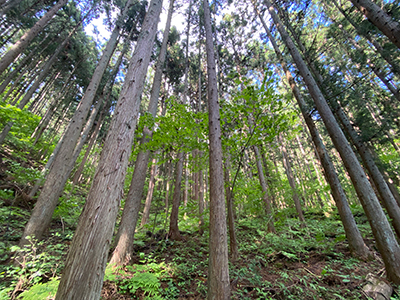
Planted forest around former Chibamura
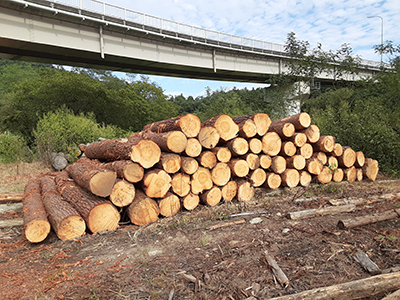
Red pine logged in the national forest
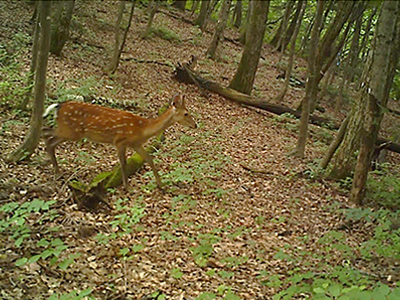
Sika deer photographed in Minakami
Mitsubishi Estate Residence Obtains ABINC Certification (Condominium Category)
Mitsubishi Estate Residence has continued to obtain the Association for Business Innovation in Harmony with Nature and Community's ABINC certification in the condominium category, certified annually since 2014, when this particular category was first launched. Since February 2015, the company has also been promoting BIO NET INITIATIVE, a biodiversity preservation program at The Parkhouse built-for-sale condominiums. Under this initiative, the company develops greenery plans for each condominium premise in a manner that will help preserve biodiversity. The company aims to obtain ABINC certification (condominium category) with projects that demonstrate particularly high levels of contribution to preservation of biodiversity. We will continue to make efforts in environmentally friendly urban development and residential development for the preservation of biodiversity and sustainable use.
About ABINC certification (condominium category)
ABINC certification (condominium category) evaluates and certifies efforts at companies such as the creation of green spaces that consider biodiversity and the management and use of green spaces, from the four perspectives of (1) creating environments that contribute to biodiversity, (2) maintenance and management that considers biodiversity, (3) communication activities, and (4) other initiatives. Specifically, the 18 categories below have been established as the criteria for evaluation.
18 categories of ABINC certification (condominium category)
1Size of area that contributes to biodiversity
2Cubic volume of greenery
3Creation of cohesive green spaces
4Depth of soil that supports plants
5Harmony with surrounding environment
6Creation of vegetation that is rooted in the community
7Creation of high-quality rooftop and wall greenery that contributes to preservation of biodiversity
8Consideration of animal habitat and movement routes
9Appropriate management of types and volumes of chemical substances used
10Consideration of water environment
11Consideration of the material cycle
12Monitoring of indicator organisms
13Measures to counter non-native species
14Qualifications of managers, etc.
15Collaboration with the community and experts
16System of resident, management association, and residential management trustee initiatives
17Promotion of environmental education programs
18Preservation of rare local species
See the following for information on ABINC certification status.
ESG Data > E: Environmental data > (2) Other > 5. Green Building Certification
Conservation and Protection Activities to Pass Down the Nature of Miyakojima, Okinawa Prefecture to the Next Generation
Conservation and Protection Activities to Pass Down the Nature of Miyakojima, Okinawa Prefecture to the Next Generation

Beach clean-up (Shimoji Island)
Mitsubishi Estate and Shimojishima Airport Management, a Mitsubishi Estate Group company, have been carrying out environmental conservation activities with participation by Mitsubishi Group employees since July 2018 to preserve the rich natural environment of the Miyakojima area in cooperation with Miyakojima City, The Nature Conservation Society of Japan, the non-profit organization Miyako Island Sea Environment Network, and other groups.
- 1)Beach clean-up activities: Beaches are Miyakojima City’s biggest tourism resource and form beautiful landscapes with elevated coral reef vegetation. However, the increase in plastic waste and other flotsam has been an issue of concern. Under the direction of the non-profit organization Miyako Island Sea Environment Network, beach clean-ups were carried out on the beaches of Shimoji Island and Miyako Island.
- 2)Reforestation activities for the grey-faced buzzard: The grey-faced buzzard, a member of the hawk family, is the official bird of Miyakojima City. Positioned at the apex of the local woodland ecosystem, it is an index species for rich biodiversity of the local woodland. The grey-faced buzzard, which is a migratory bird, visits Japan in the spring from its winter home in Southeast Asia and then migrates via Miyako Island after spending the breeding season in the woodlands of mainland Japan. However, over the past few years, there has been a decline in numbers due to the devastation of the woodland that serves as its mating ground, a decline in forests in stopover sites, including Miyako Island, and poaching at its winter home, and it has been designated an endangered species. In the 1980s, approximately 50,000 grey-faced buzzards were identified on the Miyako Islands, but their numbers fell to 6,000 in 2021, and the decline in forests where the grey-faced buzzards can rest during migration remains a major issue. Since 2022, with the cooperation of Miyakojima City and under the direction of the Nature Conservation Society of Japan, the Wild Bird Society of Miyako, and Miyako Forest Cooperative, Alexandrian laurel trees and other native species were planted on Irabu Island of the Miyako Islands. The location where the trees were planted was densely populated with wild tamarind, which is listed in “100 of the World’s Worst Invasive Alien Species” (International Union for the Conservation of Nature). Going forward, we will also plant other species of trees such as the Luchu pine with the aim of reviving a natural environment with rich biodiversity where the grey-faced buzzards will be able to thrive.
The Mitsubishi Estate Group will continue to promote protection of the rich natural environment as well as development of the local economy.
Sunshine Aquarium Coral Conservation Activities
Sunshine Aquarium Coral Conservation Activities
Sunshine Aquarium, operated by Sunshine City, a Mitsubishi Estate Group company, is an urban aquarium located in a high-rise building, and it is the first of its kind in Japan. Conceived as an “oasis in the sky,” its considerable ingenuity reveals the true form of living creatures in dynamic exhibitions that provide the sensations of the sky, light, water, and greenery. Since opening in 1978, it has served the four roles of an aquarium: environmental education, recreation, research, and conservation of species. It has been particularly focused on providing visitors with “impressive discoveries” to stimulate their interest in the biological environment. In 2006, the aquarium launched the Coral Project in cooperation with Onna Village in Okinawa Prefecture, and has been implementing two initiatives: the Coral Restoration Project and the Coral Reef Regeneration Project.
The coral reefs, which are the symbol of thriving marine environment, are in a gradual decline due to factors such as coral bleaching caused by global warming of the oceans, the natural enemy of coral. The decline of coral also risks the destruction of the surrounding marine ecosystem, leading to seas that will be uninhabitable for living creatures. In order to remedy this situation, Onna Village in Okinawa Prefecture has been implementing coral conservation activities, led by the fishermen's cooperative, since 1969. In support of these activities, Sunshine Aquarium launched a permanent exhibition on the coral of Onna and commenced the Coral Restoration Project, under which the aquarium temporarily removes part of the coral of Onna Village, grows it in tanks, and then returns it to the seas of Okinawa. This makes it possible to preserve the DNA of the coral of the Onna Village and reproduce it even if the coral is damaged due to natural disaster or environmental degradation. Since 2014, the aquarium has also implemented the Coral Reef Regeneration Project, which aims to regenerate coral reefs via sexual reproduction, with the fertilization of coral eggs by sperm. The aquarium will continue these activities into the future with the hope of restoring the coral reefs.

Coral returned in the Coral Restoration Project


Coral spawning in the Coral Reef Regeneration Project

